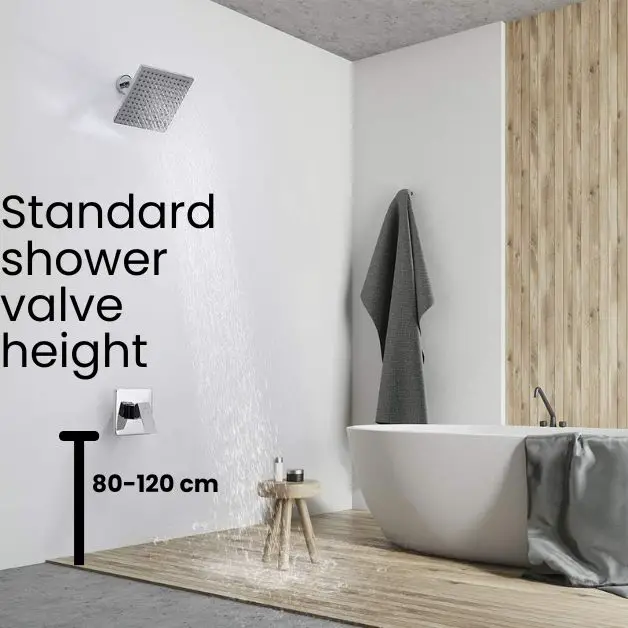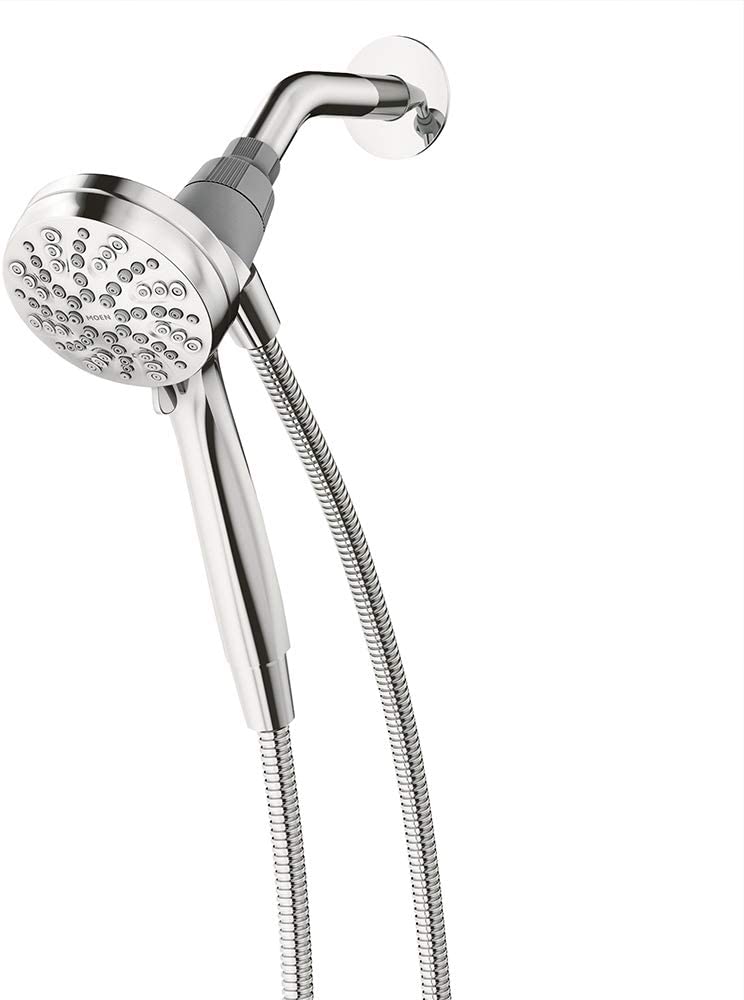When it comes to installing a shower valve, the height of the shower valve is an important factor to consider. The right shower valve height can make a huge difference in your shower experience.
In this blog post, we will discuss the ideal height of a shower valve and how to ensure it is installed correctly. We’ll also look at some potential issues that may arise from incorrect shower valve height and how to avoid them. So, let’s dive in and explore the importance of Shower Valve Height and how to get it just right!
Use links below for easy navigation
Shower Valve Height

When it comes to the height of shower valves, there is no one size fits all answer. The ideal shower valve height is based on a variety of factors, including the size and layout of your bathroom, the height of the user, and how much space is available for installation. Understanding these factors can help you determine the optimal shower valve height for your bathroom.
Standard Shower Valve Height

When it comes to Shower Valve Height, the standard is typically between 80-120 cm from the finished floor. This height is considered an ideal position that gives a comfortable reach while also providing ample clearance to easily step in and out of the shower. It also allows for ease of use when changing the shower head settings.
However, this height may vary depending on the design of the shower, your individual needs, and the type of valve used.
Shower Valve height for Bathtub Shower Units
The standard height of shower valve in a bathtub shower unit is 71 cm, or 2 feet 4 inches. This height is recommended by most manufacturers and makes it easier to access the water lines in your home without having to climb over your tub.
Lower valve height may also be an option if you have a smaller shower or prefer a more privacy-focused setting.
Shower Valve height for Shower Stalls
The height of the shower valve is important for a good shower. The shower valve should be at least 100-120 cm from the floor (depending on the shower head height), which will allow you to use your shower comfortably.
It’s a great height for users who are under 6″ and above.
Our Recommended Height for Shower Valve
When it comes to Shower Valve Height, the recommended height is typically between 100 cm and 120 cm from the finished floor. This is considered to be the ideal height for a majority of adults when taking a shower. It allows users to adjust the water temperature and pressure while standing comfortably and avoid any potential neck or back strain.
By having the valve at this height, users can keep their arms relaxed while they use the valve. Furthermore, if you have any tall family members, this height will still be comfortable for them too!
Types of Shower Valves
There are three types of shower valves: Mixer, Pressure Balance, and Thermostatic.
Mixer Shower Valves

A mixer shower valve is an older type of shower valve that looks like a normal faucet. The handle on the side of the valve allows you to adjust the water pressure, and it is turned by turning the handle clockwise or counterclockwise. When you turn it to one side, water will flow from the hot water supply, when you turn it to the other side, water will flow from the cold side.
This type of shower valve is recommended when you want to adjust the temperature of your shower. It is also used in outdoor spas and swimming pools.
Pressure Balance Shower Valves

These types of valves are known for their ability to adjust both hot and cold water flow independently. This means that you can adjust the temperature of your shower without affecting the other side. They are best suited for places where both hot and cold water is needed.
Pressure balance valves are also called “dual-action” or “double-acting” valves. These operate under pressure and also under vacuum (low pressure). This makes them very versatile and useful in many situations.
Thermostatic Shower Valves

These types of valves work by using a thermostat to regulate water flow based on temperature. As temperatures rise, so does the flow from your faucet until you reach your desired temperature.
A thermostatic shower valve uses sensors inside its body to automatically sense when hot or cold water has been flowing through it and then adjusts itself accordingly by turning off or on automatically.
Standard Shower Head Height
According to the code, a standard shower head height is 72 inches tall. This is for 5.9″ or below users, so you should make sure that your shower head is at least this high.
If you are 6″ tall or above, you should make sure that your shower head is at least 80 inches above the shower pan, and that your shower valve height is at least 40 inches from the floor in both cases.
In this way, you can have a great showering experience.
Local Code for Shower Head Height
There isn’t a standard height for shower heads.
The code that governs the height of your shower head is called the local plumbing code, and it’s based on where you live. The code will vary by state and city, so it’s important to check with your local municipality for information about the code in your area.
In general, shower heads should be installed at a height of 72 to 80 inches from the floor. You can install them higher if you want or lower if that’s more comfortable for you.
Types of Shower Heads
There are four major types of shower heads: single spray, handheld, rainfall, and LED.
Single Spray Shower Head
This type of shower head consists of a single nozzle that sprays water out in one direction. It is the most common type of shower head and is used for normal showers.
Single spray heads usually don’t include any features like massage or color-changing options. They’re great if all you want is a simple way to cleanse yourself after work or school!
Handheld Shower Head

A handheld shower head is similar to a handheld wand when it comes to its style and design. Handheld shower heads vary in size and function, but they all have one thing in common: They’re designed to be held by hand or placed on the wall above your head while you shower.
Handheld showers usually have a lever on them so that you can adjust the flow level easily.
Rainfall Shower Head

Rainfall shower heads are another type of shower head that uses a gentle stream of water at low pressure for soothing water flow. They’re often used by people who prefer gentle rain showers over streams of water.
LED Shower Head

The LED is perfect for people who want their showers to be as beautiful as possible—it can change colors, have different types of light settings, and more!
Most Commonly Asked Questions
Below are a few of the most commonly asked questions about the ideal shower valve height and how it affects water pressure.
Does shower head height affect water pressure?
The height of a Shower Head does not directly affect water pressure, which is determined by the strength and flow rate of the water supply. However, if the shower head is positioned too low, it can cause the water spray to hit the user’s head and shoulders, which can make the shower feel less powerful.
Similarly, if the shower head is positioned too high, the water may not reach the user’s body as effectively, which can also make the shower feel less powerful. So, the optimal height for a shower head is around 80-90 inches or (203-229 cm) above the floor to ensure that the water spray is aimed at the top of the user’s shoulders for an optimal shower experience.
What happens if the shower valve is installed too high?
If the shower valve is installed too high, it can cause inconvenience for shorter individuals, children, and those with mobility issues. It can also make it difficult to reach and adjust the valve.
Can the shower valve be installed lower than the standard height?
Yes, the shower valve can be installed lower than the standard height, but it is important to ensure that it is still within reach and accessible for all users.
What tools do I need to install a shower valve at the standard height?
You will need a level measuring tape, adjustable wrench, pipe cutter, and Teflon tape to install the shower valve at the standard height.
Can I install the shower valve myself?
While it is possible to install a shower valve yourself, it is recommended that you hire a professional plumber to ensure that it is installed correctly and safely.
What type of shower valve should I choose?
There are several types of shower valves available, including pressure-balancing valves, thermostatic valves, and mixer valves. The type of valve you choose will depend on your specific needs and preferences.
Can I replace a shower valve without tearing out the wall?
In some cases, it is possible to replace a shower valve without tearing out the wall. However, this will depend on the specific situation and the type of valve that needs to be replaced.
How do I know if my shower valve needs to be replaced?
If you notice that your shower valve is leaking, making unusual noises, or not functioning properly, it may be time to replace it.
Bottom Line
When it comes to installing a shower valve, one of the most important considerations is the height of the valve. Proper shower valve height is essential for both comfort and safety. Installing the shower valve at the wrong height can lead to several inconveniences and potential risks.


